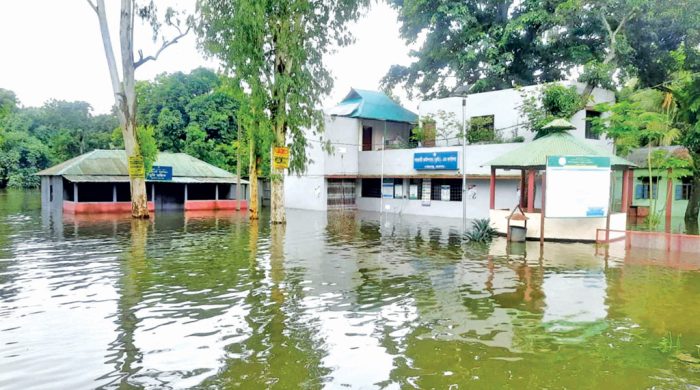Inadequate relief leaves flood victims starving

- Update Time : Tuesday, July 9, 2024
- 20 Time View

Hundreds of people in the flood-stricken north passed yet another busy day on Monday as they rushed between places, mainly in their boats, searching for flood relief that never arrived.
Those who were lucky enough to get to a place where generous individuals reached for food, water, and other relief materials found the supplies inadequate in the end, with most returning empty-handed.
It has been for three weeks that some areas remain flood-affected in the northeast, with houses barely standing in ocean-like haors.
Heavy winds made it almost impossible to cook, even if anyone had enough rice supplies.
The north and northeast are home to the country’s poorest segments of people who cannot get enough to eat even during normal times and suffer more from malnutrition than any other place in the country due to persistent poverty.
The flood compounded their misery, abruptly bringing their agrarian life and livelihood to a halt, leaving them, their children, and the elderly to starve and remain thirsty for days.
‹I have come to realise once again that perhaps I am the unluckiest person on earth,’ said Sufia, 50, a resident of Goailpuri village in Jatrapur union in Kurigram.
She spotted two teams with relief supplies on Monday and even rushed there as fast as she could, but did not get anything.
Sufia took shelter in a local school, the only land surface to be seen in the area, for a week with his two sons and jobless husband.
Three relief teams have gone there so far, but she was on nobody’s list.
The last team she encountered was sent by the Kurigram zila parishad but the supplies with which it came could meet only a third of the demand, said a member of the team.
Kajal Miah, who lived most of his days in the past three weeks at the Kheya Ghat shelter of Rajnagar in Moulvibazar, was among the lucky to receive a packet of relief materials supplied by local scouts containing 10kg of rice, one kg of lentil, five litres of oil, and some dry foods.
‘It can’t meet our hunger,’ said Kajal, who has a family of six members.
‘We come from an area where even our neighbours are poor, just like us. We have nowhere to come from,’ he said.
The Moulvibazar district is officially home to 3,14,277 flood-affected people, for whom the government has so far allocated 3,505 packets of dry food, 1,200 packets of cooked food, and 74,000 pieces of water purifying tablets.
The district’s deputy commissioner, Urme Binte Salam, avoided giving a direct answer on whether the relief supply was enough.
‘Different private organisations and individuals have joined hands with the government in helping the flood-affected people,’ she said.
Local representatives in northern districts are literally trying their best not to stand in sight of the people, for they are embarrassed with the help so far offered to the people in need.
In a flood shelter in Gobordhon of Rangpur’s Gangachora, Kalam has been living for five days, and he has not gotten any flood relief yet.
‘For 7,000 stranded people, I received only 300 packets of dry food once,’ said Abdullah Al Hadi, chairman, Lakkhitari union parishad.
For the 4,500 people affected by the affected by the flood in Mohishkhocha union parishad of Aditmari in Lalmonirhat, the government supplied 200 packets of dry food and Tk 20,000 in cash, the union parishad’s chairman, Mosaddek Hossain Chowdhury, told New Age correspondent in Lalmonirhat.
‘I am literally hiding from the people,’ he said.
This is the third wave of flooding sweeping over the northeast this monsoon season. Some places in the northeast have been reeling under relentless flooding since June 14. At the peak of the second wave of flooding that started in the second week of June, the number of affected people in the Sylhet division officially reached two million.
The third wave started on July 1, this time hitting five northern districts as well. On Sunday, disaster and relief state minister Mohibur Rahman said that the ongoing flood affected 20 lakh people in 18 districts.
In aid of such a massive number of affected people, who are mostly poor, the government has so far allocated Tk 2.85 crore in cash, 8,500 tonnes of rice, 57,500 packets of dry food, and Tk 40 lakh in cash each for baby food and fodder.
The flood this year struck people very hard, particularly because of staggering inflation over the past two years.
The Flood Forecasting and Warning Centre data revealed on Monday that the 10 rivers flowing above their danger levels at 21 points fell very slowly, indicating that the flood and suffering of the people would linger.
The Jamuna flowed 112cm above the danger mark at Jagannathganj in Jamalpur, 76cm above the danger mark at Bahadurabad in Jamalpur. The Brahmaputra flowed 55cm above the danger mark at Chilmari in Kurigram while the Kusiyara flowed 57cm above its danger mark at Amalshid.
The FFWC predicted the overall flood situation to improve, but slowly because of continued heavy rain inside Bangladesh and its adjacent area across the border in India.
The Bangladesh Meteorological Department recorded the country’s highest rainfall of 82mm in Tentulia, predicting that precipitation activities might increase after five days.















